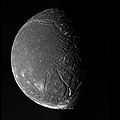References
- ↑ Strobell, M.E.; Masursky, H. (1987). "New Features Named on the Moon and Uranian Satellites". Abstracts of the Lunar and Planetary Science Conference. 18: 964–65. Bibcode:1987LPI....18..964S.
- ↑ "Nomenclature Search Results: Ariel". Gazetteer of Planetary Nomenclature. USGS Astrogeology. Retrieved 2010-11-29.
